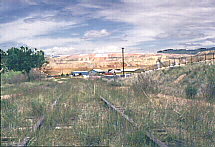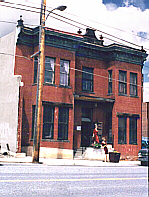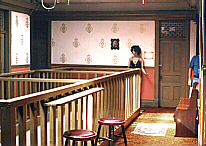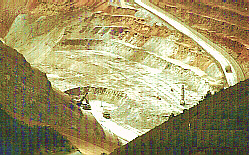 In our travels, we try not to favor one place over
another, but there will always be exceptions. Butte
Montana holds that distinction for me. Arriving late in
the evening, as we turned east into town, we were
presented with a most spectacular sight. Sitting on the
continental divide, 3500 feet above us, and 8500 feet
above sea level, was the 90 foot tall “Our Lady of the
Rockies” statue. It is the result of a magnificent human
determination which saw a dream, grow into 6 years of
grueling effort by local workers. These individuals
produced the money, land, and an army of faithful and
devoted volunteers, who blasted a road to the top of the
Rockies, so that others might understand the beauty of
this land, and behold the view of Butte below.
In our travels, we try not to favor one place over
another, but there will always be exceptions. Butte
Montana holds that distinction for me. Arriving late in
the evening, as we turned east into town, we were
presented with a most spectacular sight. Sitting on the
continental divide, 3500 feet above us, and 8500 feet
above sea level, was the 90 foot tall “Our Lady of the
Rockies” statue. It is the result of a magnificent human
determination which saw a dream, grow into 6 years of
grueling effort by local workers. These individuals
produced the money, land, and an army of faithful and
devoted volunteers, who blasted a road to the top of the
Rockies, so that others might understand the beauty of
this land, and behold the view of Butte below.
 Although
it was created in the likeness of Mary, Mother of Jesus,
it is entirely nondenominational. The project began on
December 29, 1979. Men and women in all walks of life
and almost every religion worked to pave the way for the
statue. The base of the statue was poured with 400 tons
of concrete in September of 1985. With a spiritual
energy which at times seemed to have no bounds. Political,
religious and legal restraints were swept aside, and on
December 17, 1985, supported by the U.S. Army Reserve
unit at Butte, and the Montana National Guard, a CH-54
Sikorsky Sky Crane helicopter from the Nevada Air
National Guard, lifted the first of the four sections to
be delivered to this otherwise unreachable mount. As
thousands gathered to watch, at 4:07pm, on December 20,
1985, the head piece was placed in its final position
overlooking a city that personified the gusto, and
strength of a truly blended nation. There is a center
depicting in detail the efforts of those involved at 434
North Main St.
Butte’s history goes back to the territorial gold rush of
the 1860’s. Prospectors and ranchers claimed the land
from it’s Indian inhabitants to create a mining town of
great proportion. The town swelled and shrank as each
mineral played out. With the gold gone, the population
in 1870 was around 240 people. This was not to last, as
the land was rich in minerals, and investors like William
Clark and Andrew Davis arrived to extract the various
minerals in quantity, using new mining techniques,
making them Montana’s first millionaires. William Clark
went on to become a Montana Senator and build a mansion
called the
Copper King Mansion.
Soon the boom days were
back, and by 1880’s, thousands of miners, their families,
and those who could make a living otherwise had flocked
to this rough and tumble town. In time, Butte would brag
of being the only town in America that was a mile high
and a mile deep, as shaft after shaft was dug into the
earth until the entire area was a honeycomb maze of
tunnels.
Although
it was created in the likeness of Mary, Mother of Jesus,
it is entirely nondenominational. The project began on
December 29, 1979. Men and women in all walks of life
and almost every religion worked to pave the way for the
statue. The base of the statue was poured with 400 tons
of concrete in September of 1985. With a spiritual
energy which at times seemed to have no bounds. Political,
religious and legal restraints were swept aside, and on
December 17, 1985, supported by the U.S. Army Reserve
unit at Butte, and the Montana National Guard, a CH-54
Sikorsky Sky Crane helicopter from the Nevada Air
National Guard, lifted the first of the four sections to
be delivered to this otherwise unreachable mount. As
thousands gathered to watch, at 4:07pm, on December 20,
1985, the head piece was placed in its final position
overlooking a city that personified the gusto, and
strength of a truly blended nation. There is a center
depicting in detail the efforts of those involved at 434
North Main St.
Butte’s history goes back to the territorial gold rush of
the 1860’s. Prospectors and ranchers claimed the land
from it’s Indian inhabitants to create a mining town of
great proportion. The town swelled and shrank as each
mineral played out. With the gold gone, the population
in 1870 was around 240 people. This was not to last, as
the land was rich in minerals, and investors like William
Clark and Andrew Davis arrived to extract the various
minerals in quantity, using new mining techniques,
making them Montana’s first millionaires. William Clark
went on to become a Montana Senator and build a mansion
called the
Copper King Mansion.
Soon the boom days were
back, and by 1880’s, thousands of miners, their families,
and those who could make a living otherwise had flocked
to this rough and tumble town. In time, Butte would brag
of being the only town in America that was a mile high
and a mile deep, as shaft after shaft was dug into the
earth until the entire area was a honeycomb maze of
tunnels.
 By 1980, an estimated 22 Billion dollars in minerals had
been extracted. With most mines working three shifts,
the town never slept. Drinking, gambling, and of course,
ladies of the night, were everywhere. A thriving red
light district spread out along Mercury street and Venus
Alley. The Dumas house, was built as a brothel in 1890
and ran continuously until 1982, making it the longest
running house of prostitution in America.
By 1980, an estimated 22 Billion dollars in minerals had
been extracted. With most mines working three shifts,
the town never slept. Drinking, gambling, and of course,
ladies of the night, were everywhere. A thriving red
light district spread out along Mercury street and Venus
Alley. The Dumas house, was built as a brothel in 1890
and ran continuously until 1982, making it the longest
running house of prostitution in America.
 It is the last
remaining example of Victorian brothel architecture in
this country. It had 43 rooms and ran three shifts of
girls for the miners on different shifts. The “ladies”
would sit in the windows, located along the inside
hallways, while the “gentlemen” walked by and window-
shopped. Ruby Garret was the Dumas’ last madame from
1971 to 1982 when it closed, for good, having serviced
over one million customers. It was ready for demolition
when in 1990 Ruby met Rudy Giecek and sold him the
building with the stipulation that he restore it as
closely as possible to it’s original state. Rudy has
restored most of it, and has created a museum with an
antique store on the first floor.
It is the last
remaining example of Victorian brothel architecture in
this country. It had 43 rooms and ran three shifts of
girls for the miners on different shifts. The “ladies”
would sit in the windows, located along the inside
hallways, while the “gentlemen” walked by and window-
shopped. Ruby Garret was the Dumas’ last madame from
1971 to 1982 when it closed, for good, having serviced
over one million customers. It was ready for demolition
when in 1990 Ruby met Rudy Giecek and sold him the
building with the stipulation that he restore it as
closely as possible to it’s original state. Rudy has
restored most of it, and has created a museum with an
antique store on the first floor.
 When the project became
too much for Rudy, he enlisted the aid of (ISWFACE), the
International Sex Worker Foundation for Art, Culture and
Education, who are in the process of purchasing the
building for their cultural center.
The city also has a colorful history in many other area.
Minors dissatisfied with the share of the profits they
were getting, organized and in 1878 formed Local No. 1 of
the Western Federation of Miners. This was the beginning
of an exciting and often violent relationship with the
Amalgamated Copper Mining Co., who by now had bought up
most of the other mines. In 1955 the Anaconda Co. who
held large interests in the mines, abandoned underground
mining for the less labor intensive open pit method. The
Berkeley pit, started in 1955 and closed in 1982, along
with others, changed the face of Butte. Gone forever
were the homes, boarding houses and places of
entertainment, as the open pits grew, swallowing up the
land.
When the project became
too much for Rudy, he enlisted the aid of (ISWFACE), the
International Sex Worker Foundation for Art, Culture and
Education, who are in the process of purchasing the
building for their cultural center.
The city also has a colorful history in many other area.
Minors dissatisfied with the share of the profits they
were getting, organized and in 1878 formed Local No. 1 of
the Western Federation of Miners. This was the beginning
of an exciting and often violent relationship with the
Amalgamated Copper Mining Co., who by now had bought up
most of the other mines. In 1955 the Anaconda Co. who
held large interests in the mines, abandoned underground
mining for the less labor intensive open pit method. The
Berkeley pit, started in 1955 and closed in 1982, along
with others, changed the face of Butte. Gone forever
were the homes, boarding houses and places of
entertainment, as the open pits grew, swallowing up the
land.
 Berkeley Pit, being the largest, struck water, and
began to fill. It’s waters are so toxic, they cannot be
allowed to flow over the top and into the streams around
Butte. As of yet, no solution has been found to prevent
this.
Berkeley Pit, being the largest, struck water, and
began to fill. It’s waters are so toxic, they cannot be
allowed to flow over the top and into the streams around
Butte. As of yet, no solution has been found to prevent
this.
This is but a small sampling of what is to be found in this most unusual and diversified town where mining still goes on. High on a hill behind the Montana College of Mineral Sciences and Technology is the Mineral Museum and the 12 acre mining camp and museum. In order to get a real overall look at the city along with an informative tour don’t miss taking the trolley that leaves from Butte’s information center several times daily.
*** THE END ***
